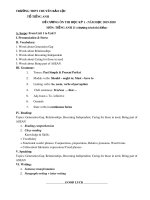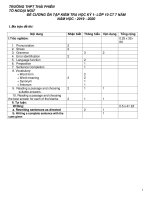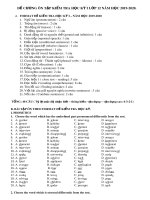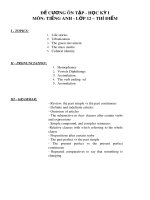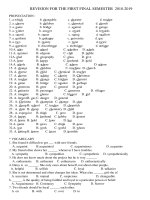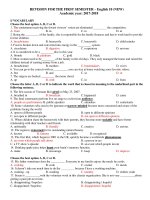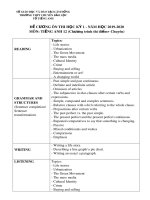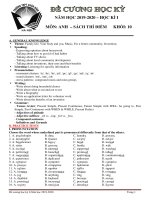Đề cương ôn tập học kì 1 môn Tiếng Anh 7 năm 2019-2020 - Trường THCS Chánh Phú Hòa
Bạn đang xem bản rút gọn của tài liệu. Xem và tải ngay bản đầy đủ của tài liệu tại đây (460.06 KB, 11 trang )
ĐỀ CƯƠNG ƠN TẬP HỌC KỲ I ANH 7 (MỚI)
KNOWLEDGE (KIẾN THỨC)
I. UNIT 1:
1. The present simple tense (Thì hiện tại đơn)
a. Form
* Tobe: is, am, are
(+) S + is/ am/ are + O/ N.
() S + isn't/ am not/ aren't + O/ N.
(?) Is/ Are + S + O/ N ?
Yes, S + is/ am/ are.
No, S + isn't/ aren't/ am not.
Ex. She (be) is twelve years old.
Ex. I (not be) am not in Dong Truc.
Ex. Is she (be) twelve years old?
Yes, she (be) is.
*Nomal verb (động từ thường):
(+) S + V(s, es) + O
Ex.He ( live) lives in Can Kiem.
They (live) live in Can Kiem.
() S + don't/ doesn't + V + O
Ex.He ( not live) doesn't live in Binh Phu.
They (not live) don't live in Can Kiem.
(?) Do/ Does + S + V + O?
Yes, S + do/ does.
No, S + don't/ doesn't.
Ex. Does He (live) live in Binh Phu?
Do They (live) live in Can Kiem?
Usage (cách dùng): Thì hiện tại đơn dùng để diễn đạt một hành động mang tính
thường xun, thói quen hoặc hành động lặp đi lặp lại có tính quy luật.
b. Dấu hiệu nhận biết của thì hiện tại đơn:
Trạng từ chỉ tần suất: always, usually, often, sometimes, rarely, seldom, never.
Các trạng từ chỉ thời gian: every + time (every day), today, nowadays, Sundays.
2. Future simple tense (Thì tương lai đơn giản)
a. Form
(+) S + will/ shall + V + O.
Ex. We (do) will do the first term test next week.
() S + will not/ shall not + V + O.
won't/ shan't
Ex. We (not do) won't do the first term test tomorrow.
(?) Will/ Shall not + S + V + O?
Yes, S + will/ shall.
No, S + won't/ shan't.
Ex. Will you (go) go to school tomorrow ?
Yes, I will.
b. Usage (cách dùng): Thì tương lai, thường là đưa ra quyết định ngay khi nói.
Ex. A: There will be a new good on tonight.
B: Then I will see it tonight.
c. Dấu hiệu nhận biết: tomorrow (ngày mai); next + time (next week, next
Monday, next Spring,...); in the future (trong tương lai).
2. Verbs of liking + Ving: (một số động từ theo sau bởi Ving)
*Form:
Ex. She like (eat) eating chewing
like/ enjoy/ love/ prefer
He doesn't like (watch) watching
don't like/ dislike/ hate
S +
+ Ving + O
They start (learn) learning at 7.3
start/ begin
They finish (learn) learning at 11
finish/ stop/ end
II. UNIT 2:
1. Imperatives with more and less
Ta thêm more hoặc less vào sau động từ, loại câu này thường dùng để đưa ra lời
khun.
Ex: Eat less fast food!
Do more exercises!
2. Compound sentence
* Cách dùng:
Khi muốn nối 2 mệnh đề của một câu hoặc 2 câu với nhau, ta sử dụng các từ
nối để thành lập câu ghép. Các từ nối phổ biến và đơn giản nhất đó là: and, or,
but, so.
Ngồi ra, các em cũng thường xun gặp những từ nối sau: because, although/
eventhough/ though
Ex. I love fish. I love chicken too
I love fish and chicken.
It is raining. I have to stay at home.
Because it is raining, I have to stay at home.
III. UNIT 3:
1. The past simple:
a. Form:
Sentence
Normal verb
Câu khẳng định
S + Ved/ V2 + O
Câu phủ định
S + didn't + V + O
Câu hỏi
Did + S + V + O ?
Tobe
S + was/ were + O
S + was/ were + not +
Was/ Were + S + O ?
b. Usage: Thì q khứ đơn dùng để diễn tả một hành động đã xảy ra và chấm
dứt hồn tồn trong q khứ.
3. Dấu hiệu nhận biết: Yesterday, ago, last week/ month/ year, in the past, in
2016,...
Ex. Uncle Ho passed away in 1969.
c. Cách thêm đi ed:
a. Thêm d vào sau các động từ theo quy tắc tận cùng là ee hoặc e
Ex. live lived, love loved, agree agreed
b. Đối với các động từ theo quy tắc một âm tiết, tận cùng bằng một ngun âm
+ một phụ âm ( trừ h, w, x) chúng ta phải gấp đơi phụ âm trước khi thêm ed.
Ex. fit fitted, stop stopped, fix fixed
c. Động từ tận cùng bằng y, ta chia ra làm hai trường hợp:
Trước y là một phụ âm, ta biến y thành i trước khi thêm ed: study ® studied
Trước y là một ngun âm, ta thêm ed bình thường: play ® played.
Với các động từ cịn lại , ta thêm ed: work ® worked, learn ® learned.
2. The present perfect:
a. Form:
Sentence
Normal verb
Tobe
Câu khẳng định
S + has/ have + Ved/ V3 + O
S + has/ have + been
Câu phủ định
S + hasn't/ haven't + Ved/ V3 + O
S + has/ have + not +
Câu hỏi
Has/ Have + S + Ved/ V3 + O ?
Has/ Have + S + been
b. Cách thành lập q khứ phân từ V3:
Với động từ thường theo quy tắc, thêm ed vào sau động từ đó: work worked,
play played.
Với động từ bất quy tắc, tra cột q khứ phân từ 2 của bảng động từ bất quy
tắc: bring brought, sing sung.
c. Usage:
Thì HTHT dùng để diễn tả một hành động xảy ra ở một thời điểm khơng xác
định trong q khứ.
Ex. He has completed his project.
Chỉ một hành động xảy ra nhiều lần trong q khứ và có thể lặp lại trong
tương lai.
Ex. Johny has seen that movie three times.
Chỉ một hành động bắt đầu trong q khứ, kéo dài đến hiện tại và cịn tiếp tục
trong tương lai.
Monica has lived in that house for 20 years.
d. Dấu hiệu nhận biết:
* since và for:
for + khoảng thời gian: for two days, for ten years,…
since + mốc thời gian: since 1994, since February,…
Ex. We have studied English for ten years.
We have studied English since 2005.
* already và yet:
already dùng trong câu khẳng định, thường đứng ngay sau have/has, thỉnh
thoảng sẽ đứng cuối câu.
Ex. We have already written our reports.
We have written our reports already.
yet dùng trong câu phủ định và câu nghi vấn, thường đứng ở cuối câu.
Ex.We haven't written our reports yet.
Have you written your reports yet?
* Một số trạng ngữ chỉ thời gian khác:
Các trạng ngữ chỉ thời gian sau thường dùng với HTHT: so far, until now, up to
now, up to present, recently, lately,…
IV. UNIT 4:
1. So sánh bằng (khơng bằng):
a. So sánh bằng:
S1 + tobe + as + adj + as + S2
Ex. She is as tall as her.
b. So sánh khơng bằng:
S1 + tobe not + as + adj + as/ so + S2
Ex. He isn't as weigh as his father.
2. So giống nhau (khơng giống nhau):
a. So sánh giống nhau:
S1 + tobe + the same + adj/ n + as + S2
Ex. She is the same tall as I.
b. So sánh khơng giống nhau:
S1 + tobe not + the same + adj/ n + as + S2
She isn't the same beautiful as her mother.
3. So sánh khác nhau :
S1 + tobe + different from + S2
She isn't the same beautiful as her mother.
4. Đáp lại đồng tình với too, so, either và neither:
a. Đồng tình trong câu khẳng định:
Khi muốn nói một người hoặc vật nào đó làm một việc gì đó và một người, vật
khác cũng làm một việc tương tự, ta sử dung lối nói đồng tình. Để tránh lặp lại
từ của câu trước, ta dùng liên từ and, và dùng một câu đơn giản có sử dụng từ so
hoặc too. Hai từ này mang nghĩa là "cũng thế". Cụ thể:
Mệnh đề chính
Mệnh đề phụ
and + S + tobe, to
Tobe
S + tobe + …
and so + tobe + S
and + S + do/ doe
Normal verb
S + V +…
and so + do/ does/
Ex: I am happy, and you are, too.
I work for a school, and she does, too.
b: Đồng tình trong câu phủ định:
Đồng tình trong câu phủ định cũng giống như đồng tình trong câu khẳng định,
chỉ khác một điều là ta thay so, too bằng either, neither. Cụ thể:
Mệnh đề chính
Mệnh đề phụ
and + S + tobe not, too
Tobe
S + tobe + not …
and so + tobe not + S
and + S + do/ does/ did
Normal verb
S + don't/ doesn't/ didn't + V +…
and so + do/ does/ did +
Ex: She isn't a doctor, and he isn't, either.
I didn't see him, and Janny didn't, either.
V. UNIT 5:
1. How many, how much (bao nhiêu)
a. How many:
Dùng trước danh từ đếm được số nhiều.
Cấu trúc cơ bản:
How many + nouns/ nounes + are there…… ?
There is + a/ an/ one + singular noun.
There are + số lượng + plural nouns/ es.
Ex: How many people are there in your family?
There are five people.
b. How much:
Dùng trước danh từ khơng đếm được.
Cấu trúc cơ bản:
How much + non count noun + is there ….?
+ do/ does/ did + V + O?
There is + some + non count noun.
S + V + SL + …...
Ex: How much water do you drink everyday?
Two liters.
* Ngồi ra how much cịn thường được dùng khi hỏi giá cả
Ex: How much does that shirt?
50.000 dong.
2. A, an, some, any
a. a và an (một)
A và an được dùng cho danh từ số ít đếm được. A đứng trước phụ âm, an đứng
trước ngun âm (tính theo cách phát âm chứ khơng phải cách viết)
a cat, a house, an ocean, an hour.
b. some và any (một vài, một ít)
some được dùng cho các danh từ khơng đếm được hoặc đếm được số nhiều ở
trong câu khẳng định.
Ex: There is some water.
There are some books on the desk.
any được dùng cho các danh từ khơng đếm được hoặc đếm được số nhiều ở
trong câu phủ định và câu hỏi.
Ex: There isn't any food.
Are there any chairs in the room?
VI. UNIT 6:
Passive voice (Câu bị động)
1. Cách dùng:Trong Tiếng Anh người ta rất hay dùng câu bị động. Trong câu bị
động, chủ ngữ nhận tác động của hành động. Câu bị động được dùng khi muốn
nhấn mạnh đến đối tượng chịu tác động chịu tác động của hành động. Nếu
trong câu có 2 tân ngữ, nếu muốn nhấn mạnh tân ngữ nào thì đưa tân ngữ đó lên
làm chủ ngữ, thường chủ ngữ hợp lý của câu bị động sẽ là tân ngữ gián tiếp.
Ex: I gave him a book.
He was given a book by me.
A book was given to him by me.
2. Quy tắc chuyển:
S + V + O + (time).
S + tobe + PII + by O + (time)
Đưa tân ngữ của câu chủ động lên làm chủ ngữ câu bị động.
Động từ của câu chủ động chuyển về dạng tobe + V3 trong câu bị động. Thì
của câu bị động chia theo thì của câu chủ động.
Chủ ngữ của câu chủ động đưa về dạng by + O.
Cụm tự chỉ thời gian trong câu chủ động đặt sau by + O của câu bị động.
3. Cấu trúc câu bị động các dạng cụ thể:
a. Thì hiện tại đơn giản: S + is/ am/ are + PII/ Ved + by O + (time).
Ex: I do my homework everyday.
My homework is done by me everyday.
b. Thì q khứ đơn: S + was/ were + PII/ Ved + by O + (time)
Ex. She washed clothes last night.
Clothes were washed by her last night.
c. Thì hiện tại tiếp diễn: S + is/ am/ are + being + PII/ Ved + by O + (time).
Ex. He is watering the vegetables in the garden now.
The vegetables are being watered by him now.
d. Thì q khứ tiếp diễn: S + was/ were + being + PII/ Ved + by O + (time).
Ex. They was painting her house at 8 a.m yesterday.
Her house was being painted at 8 a.m yesterday.
e. Thì tương lai đơn giản: S + will/ shall + be + PII/ Ved + by O + (time)
Ex. You will do first term tests next month.
First term tests will be done by you next month.
f. Thì tương lai gần: S + is/ are/ am going to + be + PII/ Ved + by O + (time)
Ex. We are going to move December next Friday.
December is going to be moved by us next Friday.
e. Thì hiện tại hồn thành: S + have/ has + been + PII/ Ved + by O + (time)
Ex. Lan has lived in Can Kiem since 2005
Can Kiem has been lived in by Lan since 2005.
f. Động từ khuyết thiếu: S + can/ could/ must/ have to
may/ might/ would
Ex. She can draw some pictures in a few minutes.
Some pictures can be drawn by her in a few minutes.
EXERCISE
I. Choose the best answer by circling A, B, C or D:
1. “What would you like to drink now?” “_______________.”
A. No, thanks B. Yes, please
C. I like to do nothing D. Orange juice, please
2. All of us enjoy _______ to classical music.
A. listen B. listens C. listening D. listened
3. She worked very hard, _______she passed all her exams.
A. because B. and C. so D. but
4. Hoa looks red. She was outdoors yesterday. Perhaps she has _______
A. flu B. sunburn C. spots D. stomachache
5. My family has decided to use _________ electricity by using more solar energy
instead.
A. more B. less C. much D. fewer
6. I ............... playing board games interesting because I can play them with my
friends.
A. find B. think C. say D. tell
7. “ Would you like me to turn off your computer?
“ ______________. I’ll do it myself”
A. No, thanks B. Yes, please C. Don’t do it D. Of course
8. You like playing monopoly or chess, your hobby may be _______.
A. collecting things. B. playing sports
C. dancing D. board games
9. I …………….. Nha Trang when I was a child.
A. visit B. visited C. will visit D. have visited
10. He …………… to the USA so far.
A. is B. was C. will be D. has been
11. Americans eat a lot of junk food, ………….junk food causes obesity.
A. but B. and C. so D. because
12. Tim: I feel itchy and my nose is running. Doctor: ………………………..
A. Wash your hair more. B. I think you have the flu.
C. Drink more water. Eat less meat D. I think you have a stomachache.
13. Pick out the word whose main stress is placed differently from the others.
A. allergy B. headache C. temperature D. obesity
14. Choose the word that has the underlined part pronounced differently from the
others.
A. cold B. curly C. ocean D. clothes
15. It is interesting _____________ tree leaves from different countries.
A. collecting B. to collect C. collect D. collects
16. My dad enjoys ________ his bike to work.
A. to ride B. ride C. rides D. riding
17. I love cooking, _________ my sister doesn’t.
A. because B. so C. but D. and
18. Laughing is good _______ your health.
A. for B. to C. with D. of
19. Choose the word that has the underlined part pronounced /3:/
A. dear B. pear C. earn D. heart
20. Choose one mistake and correct it.
I find carve eggshells boring because it takes
a lot of time to complete
one shell.
A B C D
II. Put the verbs in the correct form.
1. I enjoy (fish) .................................................. because it (be) ……………….…
relaxing.
2. Jane will play chess after she (finish) …………………………. school.
3. What …………………… your mother often (do) ………………………at
weekends?
4. I think, in the future people (not play) …………………………………
individual games.
5. We find (arrange) ……… flowers interesting because it (help) …………… us
relax.
6. I (not collect) ………….……………………… dolls when I grow up.
III. Complete the passage with the words given
bought competition singing there on English
Mary’s hobby is singing. She enjoys (1) ………………………… very much.
When her brother (2) ………………………… a karaoke set last month, Mary was
so glad that she sang every day after dinner. She likes to sing only (3)
………………………… songs. In fact, she has already sung all the songs found
(4) ………………………… the karaoke discs. Minh is singing in the karaoke (5)
………………………… organized by the RC Center this Saturday. Her family is
going (6) ………………………… to support her.
IV. Choose the best answer to complete the sentences by circling A, B, C or D
1. ............... do you find making pottery? – I finding making pottery interesting.
A. What B. How C. Why D. Whe
2. Jenny...................two eggshells and he will continue the third one.
A. carves B. has carved C. carved D. will carved
3. My father hates ………… coffee. He prefers tea.
A. to drink B. drink C. drinks D. drinking
4. I have a temperature,………………………………. .
A. but I go to bed early B. so I feel tired
C. or I am putting on weight D. and I eat more vegetables
5. Which word has the underlined part pronounced differently from the others?
A. away B. answer C. sunburn D. picture
6. Which word has main stress differently from the others?
A. volunteer B. charity C. melody D. calorie
7. Beethoven ………….. a lot of songs.
A. composes B. composed C. has composed D. compose
8. Liz: I am so nervous that I am putting on weight./ Tony:
……………………….. A. Wash your hand more B. Eat less junk food
C. Sleep more D. Sunbathe less
9. Jack spends almost his time staring at his smartphone, ……..….. is very short
sighted.
A. and B. or C. but D. so
10. My father loved …………. horseriding when he was young.
A. doing B. going C. playing D. taking
11. She feels itchy and her nose is running. She says she has ………….. .
A. headache B. toothache C. allergy D. flu
12. Jenifer says that she ……………. collecting dolls, but she…………… in the
future.
A. will like/ won’t continue C. likes/ continues
B. likes/ won’t continue D. will like/ continues
V. Choose the best answer to complete the passage:
Headache is a very common disease. The symptoms (1)…….. a headache are
various. People may (2)……….. pains only one side of the head. Sometimes when
the pain goes away, the head is sore. People have a headache (3) …………. they
work too hard or they are too nervous about something. (4)……….. can help cure
the disease but people usually have to do more than taking tablets. They can
prevent headaches by changing their diets or their (5)…………… or simply by
going to bed.
1. A. on B. in C. of D. at
2. A. be B. have C. happen D. take
3. A. when B. but C. so D. and
4. A. Medicine B. Doctor C. Sport D. Fruit
5. A. life B. lifestyles C. hobbies D. working
VI. Complete each sentence so it means the same as the sentence above.
1. I didn’t go to school because I was sick.
> I was sick, so ………………………………….
2. It will be good if you eat less meat and more vegetables.
> You should ………………………………………………………………………
3. He likes playing computer games in his free time.
> His hobby is ……………………………………………………………………..
4. I am interested in watching TV in the evening.> I
enjoy……………………………………
5. I think that learning English is important.>I find
…………………………………………..
6. My brother enjoys coffee very much. > Coffee ……………………………..
………………..
7. What is the price of a plate of fried rice? > How
……………………………………………..
8. This food has some meat and tofu. > There …………………………………….
……………...
9. Chicken is my sister’s favorite food. (likes)
>……………………………………………….....
10. There is sugar in many kinds of food. (have) >……………………………
VII. Use the words given to write a paragraph about Huong’s hobby.
Huong/ be/ student/ class 7A/ Quang Trung school. Collect glass bottles/ be/ one
of/ favorite hobbies. She/ start/ hobby/ when/ ten years old. She often/ share/
hobby/ sister. She/ find/ hobby/ interesting/ useful. She/ feel/ happy/ when/ look at/
beautiful flower vases/ make/ them. She/ continue/ hobby/ future/ because it/ help/
save/ environment.

